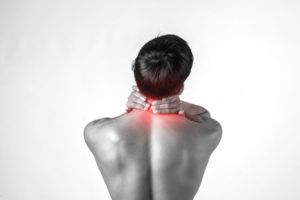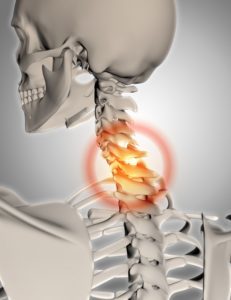Neck and shoulder pain are common nowadays due to bad posture habits, working on computers continuously, using mobile phones for long hours, inadequate sleep, and lack of exercises for strengthening the muscles that support our spine. Due to this, every third person is suffering from CERVICAL SPONDYLOSIS or other spinal issues.
Thankfully, Ayurveda has got a reliable and effective cure for spinal problems. You only need to change your lifestyle and diet patterns. But first of all, we should know more about cervical spondylosis.

WHAT IS CERVICAL SPONDYLOSIS
There are 33 vertebras in our spine which make the spinal column. First 7 vertebras {C1-C7}, located in the neck region, are called a cervical spine. The neck has the greatest range of motion because of the first two bones. The first vertebra C1 is called ATLAS that connects directly to the skull. This joint allows the “YES” motion of the head. The second vertebra C2 is called AXIS. This joint allows for the side to side or “NO” motion of the head.
The main function of the cervical spine is to support the weight of the head i.e. about 10 pounds and help it move. Each vertebra of our spine is separated and cushioned by intervertebral discs, preventing the bones from rubbing together. The vertebras of cervical spines are surrounded by a network of muscles, joints, ligaments, blood vessels, and nerves.
 Cervical Spondylosis is a common age-related condition that affects the joints and disc in the cervical spine. It is also known as CERVICAL OSTEOARTHRITIS OR NECK ARTHRITIS. It is a degenerative disease due to aging which causes wear and tear of bones and cartilages. This condition is usually common in aged and elderly people.
Cervical Spondylosis is a common age-related condition that affects the joints and disc in the cervical spine. It is also known as CERVICAL OSTEOARTHRITIS OR NECK ARTHRITIS. It is a degenerative disease due to aging which causes wear and tear of bones and cartilages. This condition is usually common in aged and elderly people.
There are several medical terms that sound similar to it and are often confused with Spondylosis. These are
Cervical Spondylitis – It is an inflammatory condition of the cervical spine. It may include one or more than one vertebra.
SPONDYLOLYSIS– It is the incomplete development and formation of connecting parts of the vertebra.
SPONDYLOLISTHESIS– It is the forward or backward displacement of the body of one vertebra in relation to adjacent vertebrae.
SPINAL STENOSIS- It is the narrowing of the spinal canal cause pressure on the spinal cord and nerves due to limited space which further causes pain, numbness, and tingling sensation.
 CAUSES OF CERVICAL SPONDYLOSIS
CAUSES OF CERVICAL SPONDYLOSIS
Age, gender and occupation are the risk factors for having Cervical Spondylosis. Aging increases the degeneration of the spine. Although it is common in both sexes, the degree of severity is greater in males. An increased incidence has been noted in patients who carried heavy loads on their head or shoulders, dancers, gymnasts, and computer professionals. Genetic factors are also responsible for this disease. Obesity, sedentary lifestyle and lack of exercise are also responsible for the early onset of degeneration changes in the spine.
In an early age or young age, Cervical Spondylitis is common. It is due to poor posture, overuse of neck muscles, holding the neck in an uncomfortable position for a prolonged period of time, being overweight and inactive, weakness of neck muscles due to a lack of exercise. Many people experience neck pain occasionally due to injury, whiplash, overuse of neck muscles and stress.
SYMPTOMS
- Most common symptom is neck and shoulder pain which can radiate to arm and fingers. Pain can be chronic with long periods of remission
- Sub occipital pain and headache with nausea, vomiting, and vertigo
- Limited flexibility, Stiffness in neck and back which cause limited range of motions
- Tingling, numbness and weakness which mainly affects shoulders and arms, sometimes in legs also
- Less frequent symptoms include loss of balance and loss of bladder or bowel control, urinary incontinence and increased frequency of micturition. These symptoms show immediate medical attention
- In severe cases, arthritis will deteriorate the joint causing vertebrae to fuse together and abnormal curvature of the spine
INVESTIGATIONS
X-ray, CT scan and MRI scan helps to check abnormalities of the spine. EMG (Electromyogram) is used to check nerve function.
AYURVEDIC VIEW OF CERVICAL SPONDYLOSIS
Cervical Spondylosis is called Greva Sandhigathvata in Ayurveda. It is caused by aggravated vata. Vata is aggravated due to vata increasing food like taking dry, cold and stale food, taking small meals with a large gap, having frequent sour, bitter and astringent food. The second reason relates to bad lifestyle habits like overindulgence in physical, mental and sexual activities, lack of sleep or staying awake at night. Aggravated vata then gets accumulated in the specific area of the cervical spine and causes pain, degeneration, stiffness, and restriction in movements.
TREATMENT IN AYURVEDA
The treatment involves detoxification and elimination of ama [Toxins], Panchkarma treatment, vata pacifying diet and lifestyle, oral herbal medicines, yoga asana, exercises, and Marma therapy.
 PANCHKARMA TREATMENT
PANCHKARMA TREATMENT
Panchkarma treatment at NIDAN HEALING AYURVEDA includes snehanam (light body massage) with pain relieving oils, swedanam (Potali massage), and greeva basti for the local area for 15 days. In case of degeneration of vertebra, disc prolapsed; stenosis matra basti is also included along with other therapies. It helps in releasing vata hence inflammation subsides and the patient gets remarkable relief in pain.
VATA PACIFYING AND BALANCING DIET AND LIFESTYLE
It includes the following:
- Warm and fresh food mainly rich in protein and fats with added butter and ghee
- Take big meals instead of small meals and never skip your meal. Do not overeat
- Sweet, sour and salty food pacifies vata. Avoid taking raw food as it increases vata. Take more watery fruits and nuts soaked overnight
- Hydrate yourself well. Take warm or fresh water instead of ice cold water. Milk products like lassi, curd, puddings, and shakes are good. Take herbal tea instead of tea and coffee
- Wake up around 6 am. Take 7-8 hours sleep daily. Avoid late nights
- Do massage with til or mustard oil daily and take a warm bath
- Do yoga & meditation daily. Do pranayam before sleep
- Follow a routine for waking up, sleeping, meals, exercise, and work
ORAL MEDICATION
It includes vata pacifying herbal medicines. Raasna helps in balancing vata. NIDARTHO CAPSULES have nirgundi, raasna, sonth, ashwgandha & giloy. It works as a painkiller for cervical pains by releasing vata as well as reduce the inflammation.


